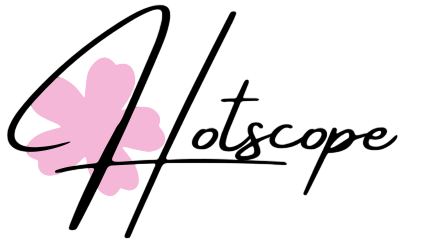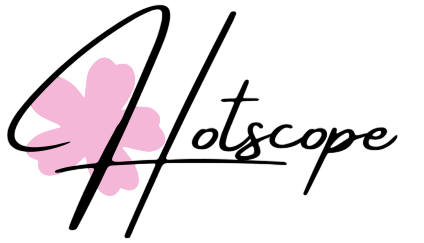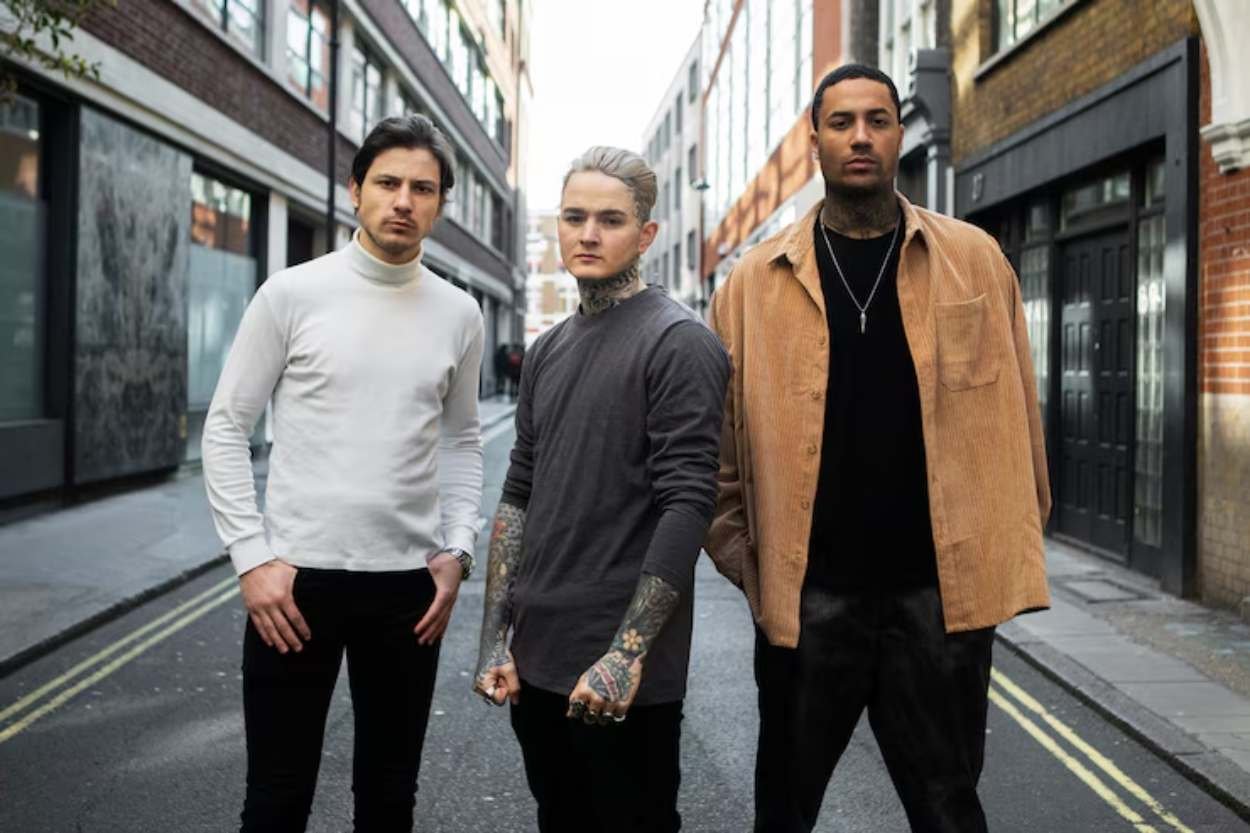Building a wardrobe can feel overwhelming when you’re staring at endless options. Walk into any men’s store, and you’ll see dozens of dress shirts in different colours, patterns, and styles. Which ones do you actually need?
Here’s the truth: you only need three dress shirts to handle 90% of situations. I’ve learned this after years of buying shirts I barely wear and watching guys struggle with the same problem.
It shows you exactly which three shirts to buy and how to wear them for everything from job interviews to weekend dates.
Why These Three Shirts Work
Before we get into the specific shirts, let me explain why this approach works better than buying random dress shirts.
Most guys make these mistakes:
- They buy shirts they like in the store but never wear
- They end up with five similar blue shirts and nothing versatile
- They waste money on trendy shirts that go out of style
The three-shirt system fixes all of this. Each shirt serves a specific purpose and works with different occasions and outfits.
Shirt #1: Classic White Dress Shirt
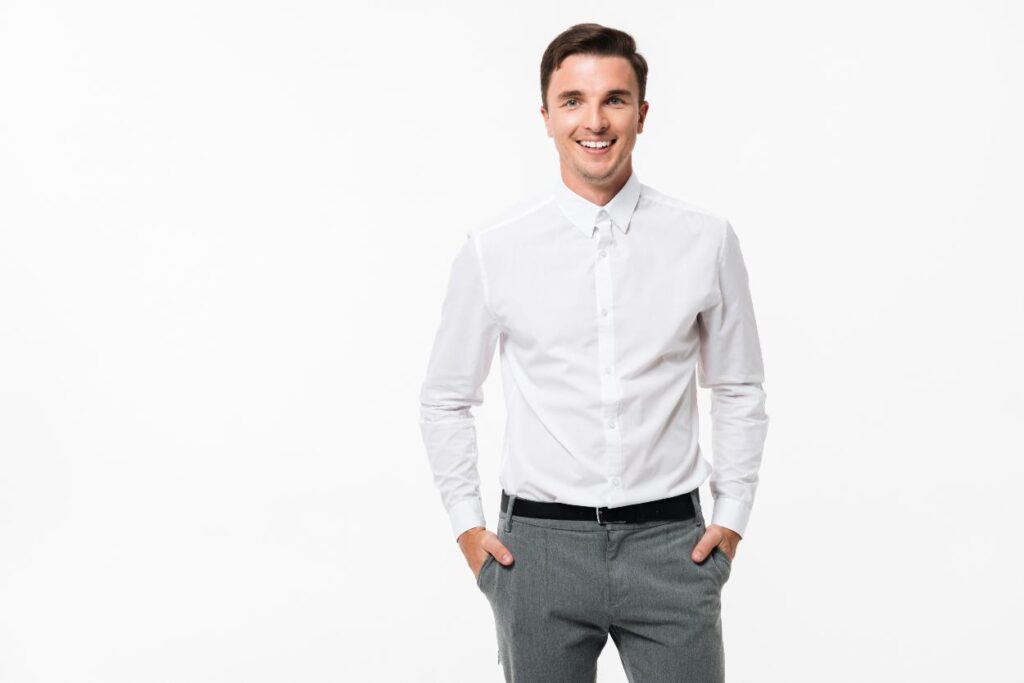
This is your foundation. A good white dress shirt is like a reliable friend – always there when you need it.
Why White Works Everywhere
White goes with everything. Seriously, everything. A white shirt pairs perfectly with a navy suit, grey pants, black tie, and brown belt—it matches everything effortlessly.
I learned this lesson the hard way. I used to avoid white shirts because I thought they were “boring.” Then I started a new job and realized I was struggling to match my coloured shirts with different ties and suits. The white shirt solved everything instantly.
What Makes a Good White Shirt
Look for these features:
- 100% cotton or cotton blend (feels better, lasts longer)
- A proper collar that stands up on its own
- No see-through fabric when you hold it up to the light
- Clean, straight seams
- Buttons that match the shirt colour exactly
Avoid these problems:
- Shirts so thin you can see your undershirt
- Collars that curl up or won’t stay flat
- Cheap plastic buttons that look obvious
- It weirdly fits that bunch up when tucked in
How to Style Your White Dress Shirt
For formal events:
- White shirt + navy or charcoal suit + solid coloured tie
- Keep it simple – let the suit do the talking
For business meetings:
- White shirt + dress pants + sport coat or blazer
- Add a tie if your workplace requires it
- Works with any color pants or jacket
For casual Friday:
- White shirt + chinos or dress pants
- Roll up the sleeves slightly
- Leave the top button undone, skip the tie
For weekend dates:
- White shirt + dark jeans + casual blazer
- Untuck it for a more relaxed look
- Add brown leather shoes and a belt
Example
My friend Sitara works in sales and travels a lot. He bought three identical white shirts from the same brand. Now, he never has to think about what shirt to pack or what matches. He grabs a white shirt, and it works with whatever suit or pants he’s wearing that day.
Shirt #2: Light Blue Dress Shirt
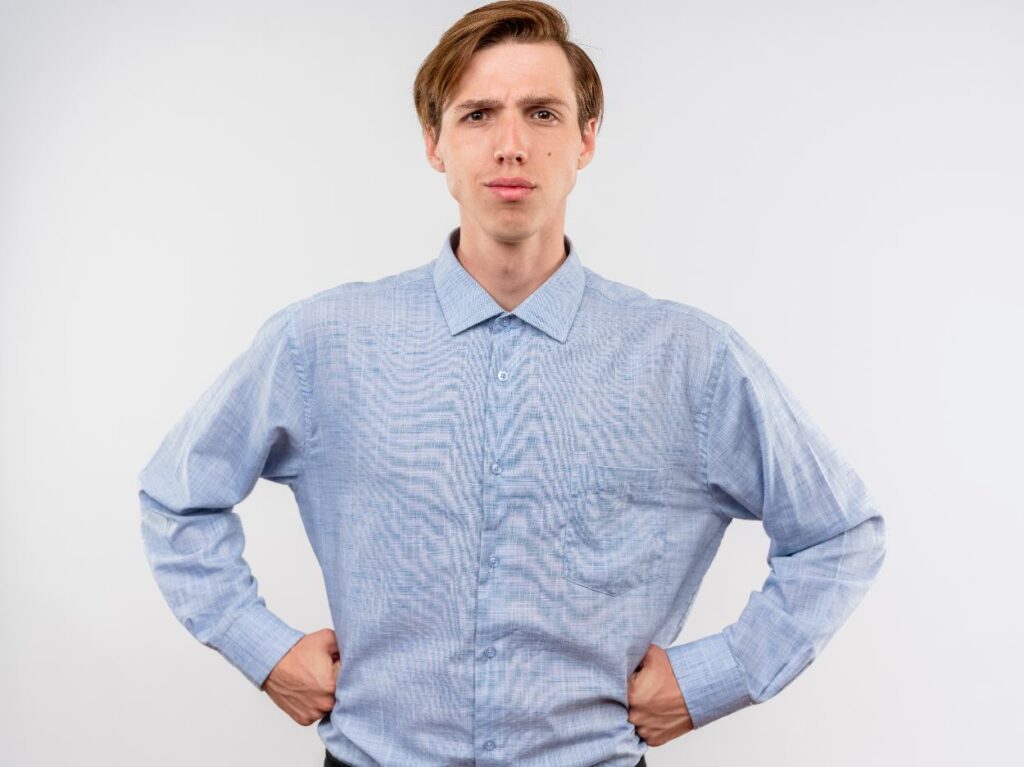
This is your versatile player. Light blue is almost as flexible as white but adds a bit more personality to your outfits.
Why Light Blue Is Different from White
Light blue gives you all the benefits of white but with more visual interest. It’s still neutral enough to work with most colours, but it doesn’t wash out your skin tone the way pure white sometimes can.
Light blue works exceptionally well if you:
- Have fair skin (adds some colour without being overwhelming)
- Want something slightly less formal than white
- Need a shirt that looks good without a tie
What Shade of Blue to Choose
Not all light blue shirts are the same. Here’s what works best:
Good blue shades:
- Powder blue (very light, almost grey-blue)
- Sky blue (classic light blue)
- Pale blue (white with just a hint of blue)
Avoid these blues:
- Royal blue (too bright and hard to match)
- Navy blue (too dark for this category)
- Bright or electric blue (looks cheap)
A helpful tip: hold the shirt next to a piece of white paper. If the blue looks subtle and calming, it’s probably right. If it jumps out at you, it’s too bright.
How to Style Your Light Blue Shirt
For job interviews:
- Light blue shirt + navy suit + conservative tie
- Creates a professional but approachable look
- Shows you understand colour coordination
For client meetings:
- Light blue shirt + grey pants + navy blazer
- More interesting than all-white but still professional
- Works great with brown or black accessories
For wedding guests:
- Light blue shirt + charcoal suit + patterned tie
- Photographs well (pure white can look washed out in photos)
- Appropriate for both church and outdoor weddings
For dinner dates:
- Light blue shirt + dark chinos + no tie
- Roll sleeves to three-quarter length
- Add a brown leather watch
Styling Mistakes to Avoid
Don’t pair light blue with:
- Light blue pants (too matchy-matchy)
- Very bright ties (create too much contrast)
- Light grey suits (not enough contrast between shirt and suit)
Do pair light blue with:
- Navy, charcoal, or black suits
- Grey or khaki pants
- Brown, burgundy, or navy ties
Shirt #3: White Shirt with Subtle Pattern
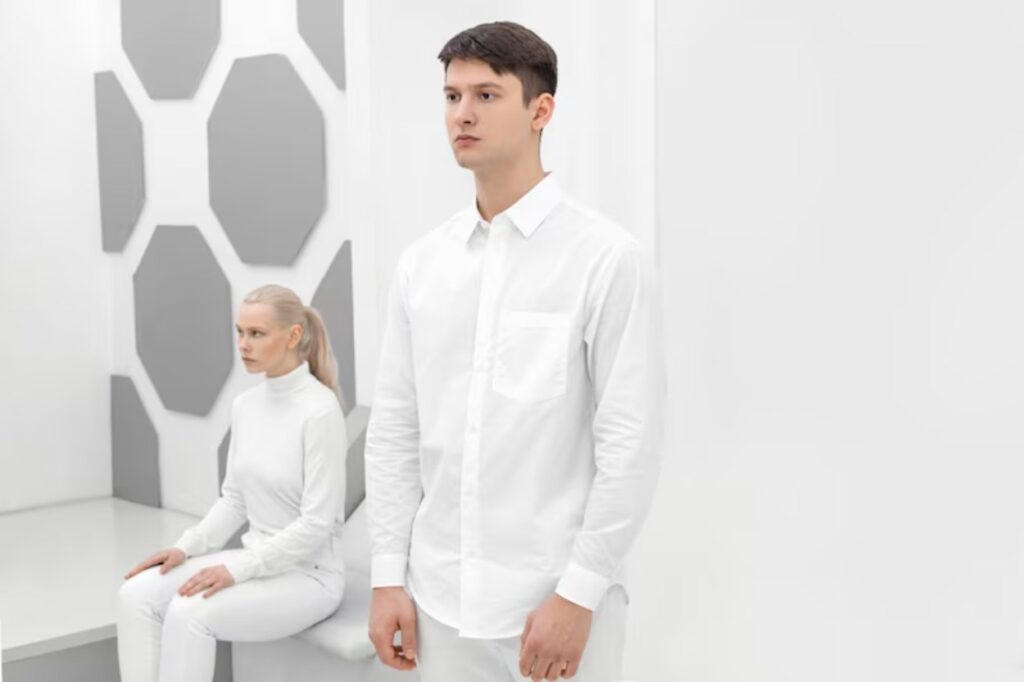
This is your personality shirt. It’s still professional and versatile, but it shows you put thought into your appearance.
Why Patterns Matter
It’s the difference between looking like you just grabbed any shirt versus looking like you understand style.
Benefits of patterned shirts:
- They hide minor stains better than solid colours
- They add texture to simple outfits
- They show attention to detail
- They photograph better than solid shirts
Best Patterns for Your Third Shirt
Thin stripes (pinstripes):
- Classic and professional
- Makes you look taller and leaner
- Works in both formal and casual settings
- Choose stripes no wider than a pencil line
Small checks (gingham or micro-check):
- Adds texture without being loud
- Works great for casual Friday or weekend wear
- Choose checks smaller than a dime
- Stick to a white background with a blue, grey, or black pattern
Subtle texture (herringbone or fine weave):
- Looks solid from a distance but has depth up close
- Very versatile and professional
- Good choice if you’re nervous about patterns
- Works like a solid shirt but is more interesting
What Patterns to Avoid
Stay away from:
- Broad stripes (look like pyjamas)
- Bright-coloured patterns (complex to match)
- Extensive checks or plaids (too casual for dress shirts)
- Multiple patterns in one shirt (confusing and busy)
- Anything you’d wear to a BBQ (save those for casual shirts)
How to Style Your Patterned Shirt
For important presentations:
- Patterned shirt + solid coloured suit + solid tie
- The pattern adds interest without being distracting
- Keep everything else simple to let the shirt be the focal point
For networking events:
- Patterned shirt + blazer + dress pants
- Excellent conversation starter (“I like your shirt”)
- Shows personality while staying professional
For casual work days:
- Patterned shirt + chinos + no tie
- More interesting than a solid shirt
- Still appropriate for unexpected meetings
For social events:
- Patterned shirt + jeans + casual blazer
- Dressier than a plain shirt but not too formal
- Suitable for dinner parties or casual dates
Pattern Mixing Rules
If you’re pairing a patterned tie with a patterned shirt, follow these simple rules:
Safe combinations:
- Small shirt pattern + large tie pattern
- Different pattern types (stripes + dots, checks + stripes)
- Same colour family but different scales
Avoid these combinations:
- Two similar patterns (thin stripes + thin stripes)
- Competing colours (both patterns fighting for attention)
- Same scale patterns (small checks + small checks)
How to Buy Quality Dress Shirts
Where to Shop
Good budget options ($30-60):
- Uniqlo (great basics, consistent sizing)
- J.Crew Factory (good quality, frequent sales)
- Bonobos (try in-store, buy online)
- Hotscope Shop (quality men’s dress shirts at competitive prices)
Mid-range options ($60-120):
- Brooks Brothers (classic American style)
- Banana Republic (modern fits, good sales)
- Charles Tyrwhitt (British style, great online deals)
Investment pieces ($120+):
- Proper Clothes (custom shirts, perfect fit)
- Eton (Swedish quality, beautiful details)
- Gitman Vintage (American-made, unique fabrics)
Fit Is More Important Than Brand
A $40 shirt that fits perfectly looks better than a $200 shirt that doesn’t fit. Here’s how dress shirts should fit:
Collar:
- One finger of space between neck and collar when buttoned
- The collar should sit flat against your neck, not gap open
- Should be comfortable when you turn your head
Shoulders:
- The seam should sit right at your shoulder point
- No pulling or bunching across the back
- It can’t be fixed by tailoring, so get this right
Chest and waist:
- Should follow your body shape without being tight
- No pulling at the buttons when you sit down
- Room to pinch about an inch of fabric at the sides
Sleeves:
- It should end at your wristbone
- Show about 1/4 to 1/2 inch of cuff beyond the jacket sleeve
- Shouldn’t bunch up when you bend your arms
Length:
- Long enough to stay tucked when you raise your arms
- Should cover your belt line completely
- Not so long that it bunches up around your waist
Sizing Tips That Actually Work
- Try shirts on at the end of the day – your body is slightly larger after eating and moving around all day.
- Bring the jacket or suit you’ll wear most often – see how they work together.
- Check the return policy – even good brands have inconsistent sizing between different shirt styles.
- Order multiple sizes online – keep what fits, and return the rest. Most online stores expect this.
Caring for Your Dress Shirts
Washing and Cleaning
For daily wear shirts:
- Wash after every 2-3 wears (unless they’re visibly dirty or smell)
- Use cool water and gentle detergent
- Hang dry when possible to prevent shrinking
For special occasion shirts:
- Consider professional cleaning for your best shirts
- Spot clean minor stains immediately
- Store on proper hangers to maintain shape
Storage Tips
Hanging:
- Use wooden or padded hangers (no wire hangers)
- Button the top button to maintain the collar shape
- Leave space between shirts so they don’t wrinkle
Travel:
- Roll shirts instead of folding for fewer wrinkles
- Pack a small steamer or use the hotel bathroom steam trick
- Bring one extra shirt in case of spills or stains
Building Outfits with Your Three Shirts
Mix-and-Match Formula
With these three shirts plus basic pants and jackets, you can create dozens of different looks:
Pants that work with all three shirts:
- Navy dress pants
- Charcoal grey dress pants
- Khaki chinos
- Dark wash jeans (for casual occasions)
Jackets that work with all three shirts:
- Navy blazer
- Grey sport coat
- Black suit jacket
- A brown or tan casual blazer
Ties that work with all three shirts:
- Navy solid tie
- Burgundy solid tie
- Grey striped tie
- Navy with a small pattern tie
Sample Outfits for Different Occasions
Job interview:
- White shirt + navy suit + burgundy tie + black dress shoes
- Shows respect for the occasion and attention to detail
Client dinner:
- Light blue shirt + charcoal pants + navy blazer + brown shoes
- Professional but approachable
Wedding guest:
- Patterned shirt + navy suit + solid tie + brown or black shoes
- Appropriate and stylish without upstaging the groom
Casual Friday:
- Any of the three shirts + chinos + no tie + leather loafers
- Professional enough for unexpected meetings
Weekend date:
- White or light blue shirt + dark jeans + casual blazer + brown shoes
- Looks like you made an effort without being overdressed
Common Mistakes and How to Avoid Them
Mistake 1: Buying Too Many Similar Shirts
I see guys with five different blue shirts that are basically identical. Instead of variety, they have redundancy.
Solution: Stick to the three-shirt system until you’ve worn each shirt multiple times and know what works for your lifestyle.
Mistake 2: Ignoring Fit for Price
Spending $200 on a shirt that doesn’t fit is worse than spending $50 on one that fits perfectly.
Solution: Always prioritize fit over brand name or price. A good tailor can fix minor issues, but they can’t perform miracles.
Mistake 3: Not Considering Your Lifestyle
Buying formal shirts when you work in a casual office means you’ll never wear them.
Solution: Think about what you actually do every day. If you’re in meetings three days a week, you need different shirts than someone who works from home.
Mistake 4: Forgetting About Maintenance
Buying shirts you can’t properly care for is setting yourself up for failure.
Solution: If you hate ironing, buy wrinkle-resistant shirts or budget for dry cleaning. If you travel a lot, choose fabrics that pack well.
When to Add More Shirts
Once you’ve mastered these three shirts and worn them regularly for a few months, you can start adding variety:
Fourth shirt options:
- Another white shirt (backup for your most-used shirt)
- Pink dress shirt (surprisingly versatile and masculine)
- Different patterns in the same style family
Fifth shirt options:
- Grey dress shirt (modern and sophisticated)
- Chambray shirt (casual but polished)
- French cuff shirt for formal events
Don’t add more shirts until:
- You’ve worn each of your three shirts at least 10 times
- You understand what occasions you dress for most often
- You have a specific need that your current shirts don’t meet
Shopping List and Budget
Budget Breakdown
Minimum investment (3 shirts): $90-180
- Basic white shirt: $30-60
- Light blue shirt: $30-60
- Patterned shirt: $30-60
Mid-range investment (3 shirts): $180-360
- Quality white shirt: $60-120
- Light blue shirt: $60-120
- Patterned shirt: $60-120
Premium investment (3 shirts): $360-600
- High-end white shirt: $120-200
- Light blue shirt: $120-200
- Patterned shirt: $120-200
What to Buy First
- If you can only buy one shirt, Get a white dress shirt. It’s the most versatile and works in most situations.
- If you can buy two shirts, Add the light blue shirt. These two will handle 80% of your dress shirt needs.
- When you’re ready for the third, Choose your patterned shirt based on what you like, but keep it subtle.
Final Conclusion
You don’t need a closet full of dress shirts to look good. You need three good shirts that fit well and work with your lifestyle.
These three shirts – white, light blue, and subtle pattern – will handle everything from job interviews to wedding receptions. They mix and match with basic suits, blazers, and pants to create dozens of different looks.
The key is buying quality shirts that fit correctly and taking care of them. A well-fitted $50 shirt that you maintain properly will serve you better than an expensive shirt that doesn’t fit or that you neglect.
